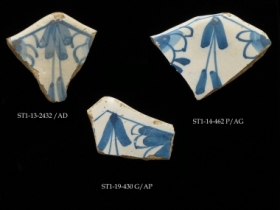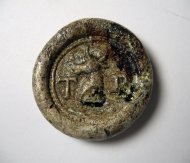Keeping a Promise to the Past
Glass and Ceramic Artifacts
Ceramics are found in abundance on 17th-century archaeological sites in St. Mary’s City. Large quantities of a wide variety of types are often found on domestic sites. Typically, ceramics are well preserved and require little work to stabilize them after excavation. High fired ceramic bodies like porcelain, stoneware, and earthenware are more durable than other materials and can be more resistant to many of the agencies of decay found in the ground.
Ceramics can suffer from years of being buried in the ground. Physical damage is the most common problem. Ceramics are almost always broken, sometimes into very small fragments, making recovery of an entire vessel difficult. The glaze may remain intact, but it will often be scratched, flaking, crumbling, and/or stained.
The biggest conservation problem with ceramics is damage from salts. Ceramics that are low-fired or very porous, such as delftwares found in the 17th-century contexts at St. Mary’s City, are most susceptible to these agents. Soluble salts, carried in solution by water, enter the pores of the ceramics during burial and are deposited throughout the ceramic structure. As wetting and drying occurs, the salts dry out and expand, causing physical damage to the ceramic body. If the a buried or excavated ceramic is dampened again, remaining salts move in and out of solution, causing more damage to the artifact. The salt ions, which can be quite large, cannot always flush back out of the artifact in the water in which it is dissolved. If the ions are carried out with the water, there is little damage. But if the salt crystals cannot get out through the ceramic body, they force their way out anywhere they can, such as through the glaze and other decorative areas on the ceramic surface, causing the glazes to pop off and be lost. Thus more areas are open and exposed on the ceramic body, which can in turn be affected by more soluble salts.
Glass can range from highly stable to highly unstable, depending on the chemical make-up of the glass and the nature of the burial environment. Chemical damage as well as physical damage is similar to that with ceramics.
Glass is liquid silica that is cooled to form a 3-D network. Modifiers are added to the glass to lower its melting point and give the glass specific properties. Fluxes, like sodium or potassium (soda ash/potash glass), are added to interrupt the network and thereby lower the melting temperature. Stabilizers, such as calcium, are added to stabilize the glass and make sure it is not water soluble. Minerals are added to give color. Lead renders glass clear; manganese lends a purple color, and cobalt leads to blue.
Degradation of buried archaeological glass depends on ground conditions. Glass is very susceptible to alkaline attack –- the ions leach out of the glass matrix and leave spaces in the glass. The K+ and Na+ ions in particular leach out. When this happens they are replaced with smaller H+ ions, leaving spaces for decay to enter. Salts and water may bond inside the glass and be held there.
Glass decays from the exterior inwards in layers. Lamination of the layers, is evidenced when the glass surfaces look like different colors, because the refractive index of the glass changes –- i.e. it is no longer transparent). Glass suffers from pitting as well –- just like metals and ceramics–- and chlorides can be held in these pits within the surfaces of the glass and cause acidic attack later while the glass is in storage.
The primary goal of glass conservation is to preserve the morphology of the glass by removing harmful salts and agents of decay, and keep the decayed, (flaking) layers intact. Additional treatments may include removal of staining and adhesion of broken fragments. All of these steps require professional training and should not be performed without careful consideration for the fragility of the glass artifact.
 Tin-glazed plate frame |
 Glass Bottle Seal |


